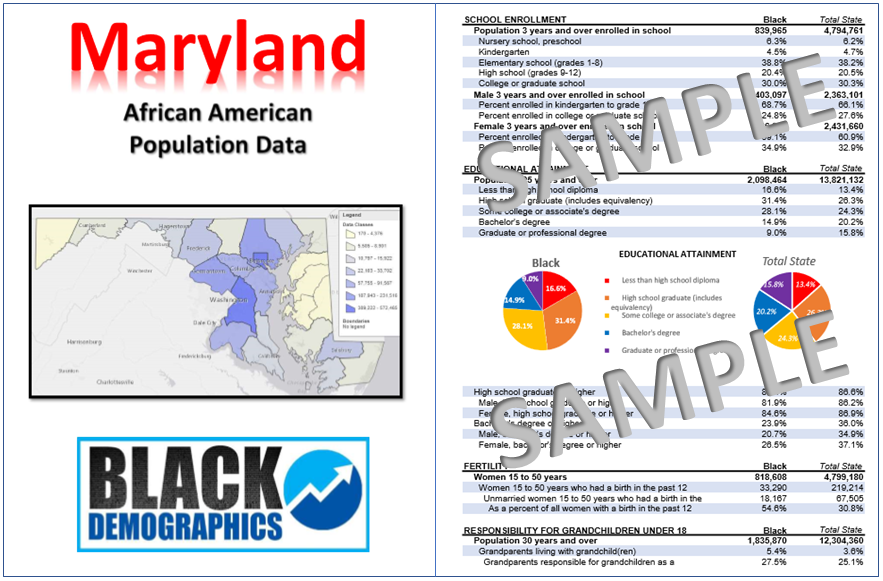Maryland
According to 2020 census data, the Black/African American alone population in Maryland was around 1,820,472 (black only), which accounts for approximately 29% of the state’s total or 1,977,453 (Black in combination with one or more race) 32% of the population.
| State Data | Black Alone | Total State |
| Total population (ACS estimate) | 1,820,472 | 6,165,129 |
| Median household income | $71,790 | 90203 |
| Bachelor’s degree or higher | 32.5% | 42.5% |
| Family poverty rate | 11.7% | 7.4% |
| Percentage households Married-couple families | 31.3% | 47.1% |
| Homeowner rate | 52.2% | 67.8% |
GROWTH
Between 1990 and 2020, the Black population in Maryland experienced substantial growth, increasing from around 1.2 million to over 1.8 million. This growth has been driven by both natural increase and in-migration from other states. As the African American population continues to grow, it has contributed to the political, economic, and cultural landscape of Maryland.
A significant proportion of Maryland’s African American population resides in urban areas, such as Baltimore, as well as the suburban areas surrounding Washington, D.C., including Prince George’s County and Montgomery County. Additionally, there are numerous Black residents living in smaller cities, towns, and rural areas across the state.
MIGRATION
Maryland has experienced a reversal of the Great Migration trend, with a noticeable number of African Americans returning to the state from the North and the West. This phenomenon, known as the “New Great Migration” or the “Reverse Great Migration,” has led to a resurgence of Black communities in the state, particularly in urban and suburban areas. This return migration has been fueled by factors such as affordable housing, job opportunities, and cultural connections to the region.
INDUSTRIES AND WORKFORCE
Historically, Black people in Maryland were employed in various industries, including agriculture, maritime occupations, and domestic work. Over time, the African American workforce diversified, finding employment in fields such as education, healthcare, and government.
In the present day, African Americans in Maryland work across a range of industries, including finance, technology, healthcare, education, and entertainment. There has been a noticeable increase in Black entrepreneurship, with many small businesses owned and operated by African Americans contributing significantly to Maryland’s economy.
HISTORY
The presence of African Americans in Maryland dates back to the 1600s when the region was a British colony. At the time, the Black population was mainly composed of enslaved Africans who were brought to the area to work on plantations. By the end of the 1700s, the Black population in Maryland had grown significantly, with enslaved people comprising approximately 29% of the state’s total population.
Following the Civil War and the subsequent emancipation of enslaved people, Maryland’s Black population continued to grow. Many African Americans remained in the state to work as sharecroppers or tenant farmers. During the Great Migration in the early 20th century, a large number of Black residents left the South, including Maryland, in search of better opportunities in the industrial North. However, Maryland’s Black population still experienced growth during this time, reaching approximately 400,000 by 1940.
As the African American population in Maryland has grown and diversified, it has contributed significantly to the state’s political, economic, and cultural landscape. African American leaders and activists have made substantial strides in local and state politics, while the state’s entertainment, music, and arts scenes have been heavily influenced by the contributions of Black artists and creatives.
Maryland has been home to historically black colleges and universities (HBCUs) such as Morgan State University, Coppin State University, and Bowie State University, which have played a vital role in the education and empowerment of African Americans in the state and beyond.
Additionally, cities like Baltimore and the suburban areas surrounding Washington, D.C., have emerged as centers for Black entrepreneurship, entertainment, and arts, with thriving creative scenes that have produced influential artists and contributed to the development of various genres, such as hip-hop and R&B.
Maryland’s African American community has played a significant role in shaping the state’s history and continues to impact its political, economic, and cultural landscape. As the Black population in Maryland continues to grow and diversify, their contributions to the state will remain an integral part of its development and identity.
Get the Complete Maryland African American Population Report


